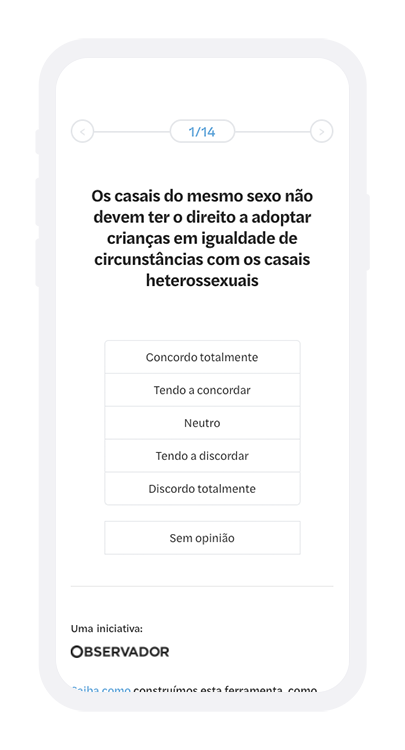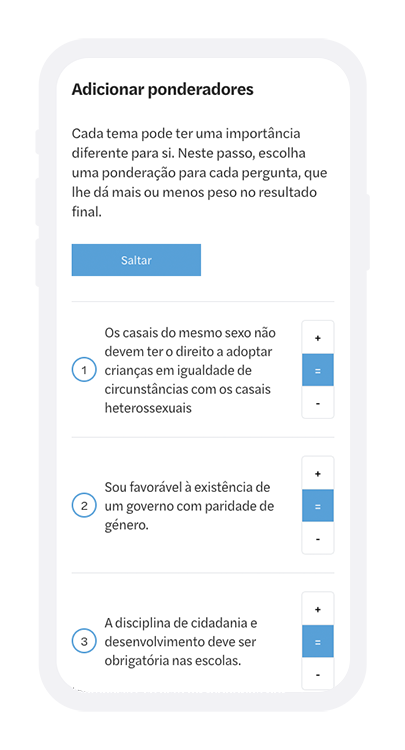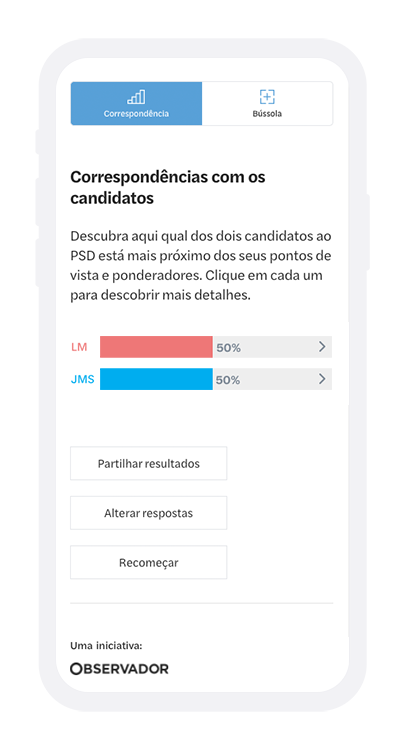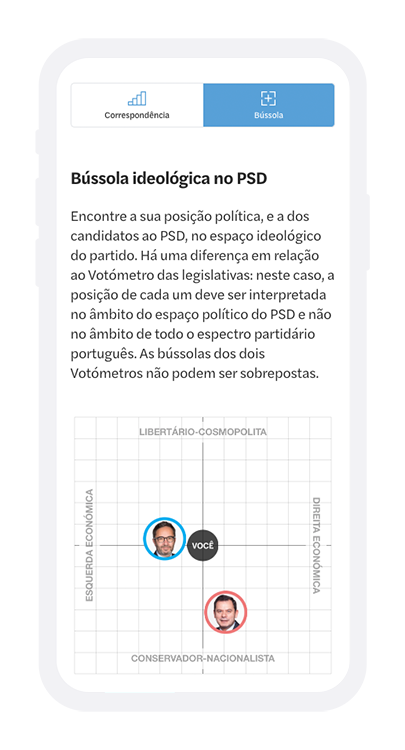After the success of the Votometer for the 2021 legislative elections, which had more than a million participants, the Observer is now launching a Votometer to monitor the internal elections in the PSD. He is closer to Luís Montenegro or Jorge Moreira da Silva. Is each candidate economically more to the right or to the left? Is he more libertarian-cosmopolitan or conservative-nationalist? What is your level of agreement with each of the candidates on the privatization of TAP? What about adoption by same-sex couples? And the possibility of agreements with Chega? These are some of the topics that the PSD 2022 Leadership Votometer allows you to explore.
Votometer. Take the quiz and find out which PSD leader candidate is closest to you
With the scientific coordination of Jorge Fernandes, a researcher at the Institute of Social Sciences of the University of Lisbon, and conceived by the Observador programming team, the new interactive tool (web and mobile) allows readers to understand which candidate for PSD leader is the most close to their values based on their positioning against 15 statements.
To help explain how this new Votometer works, how to participate and what methodology guided the development of the platform and what kind of results to expect, we have prepared a series of questions and answers.
Of course, this tool and its results are in no way a recommendation to vote for any candidate. Also, there are some topics where you can be closer to one and others where you can be closer to the other. In addition, there may be issues that are not covered in this tool but are important to your political position. Votometer is just an initiative to support reflection.
What is Votometer?
It is a free and intuitive electoral reflection tool, inspired by other scientifically validated platforms such as the European euandi and the German wahl-o-mat. The goal is to encourage political debate and literacy.
What is the advantage of participating?
One of the main objectives of Votómetro is to increase the political competence of citizens. Therefore, he wants to help them quickly acquire a set of information on the positioning of political candidates, in this case related to an internal election in the PSD, compared to their own position. Citizens do not read all the motions, statements and interviews of the candidates, so what these types of platforms do is organize the information. In Votómetro you have a reasoned explanation of the classification of each candidate, which allows you to know more about each of the positions.
Is the platform independent?
Yes. Votómetro is totally independent of any political party and candidate.
How to take part?
Just enter the online address of Votómetro Liderazgo PSD 2022 and select the “Start” button. The test starts immediately, presenting the first of 15 sentences for the user to rank their level accordingly. You have six options: “Strongly Agree”, “Tend to Agree”, “Neutral”, “Tend to Disagree”, “Strongly Disagree” and “No Opinion”.
Do I need to register to reply?
It is not necessary to register as a user. You can start responding right away.
Is participation in the platform anonymous?
Yes, participation is anonymous. Nobody will have access to your answers. Even if you are a voluntarily registered user of the Observer website or our subscriber, the response data in the tool is not associated with your user.
Do I need to pay to participate?
No. The use of the tool is free.
What kind of questions are asked?
There are 15 statements on classic topics, such as euthanasia, and more current topics, such as, for example, relations with Chega or a possible privatization of TAP.
How does participation in the platform work, in general?
It works in two phases and intuitively. First, the level of agreement of the 15 sentences presented is answered. Then, a greater or lesser weight is assigned to each of these 15 statements, to analyze the level of importance of each topic presented and then compare it with that of each candidate. Anyone who wants can skip the weighting and go directly to the final results.
How does responding to statements work?
15 phrases related to political issues that define the different parties are presented sequentially. In this stage, users are challenged to answer the level of agreement with each of these statements by choosing one of the six options mentioned: “I totally agree”, “I tend to agree”, “Neutral”; “I tend to disagree”, “Strongly disagree” and “No opinion”. This methodology is called the Likert Scale – named after the American sociologist who developed it – and is widely used to reliably measure behaviors and opinions, with a higher level of nuance, going beyond yes or no, since specify the level of agreement.

How does the response to weights work?
After answering all 15 statements, you get to the “Add Weights” section, where all 15 statements are listed on the same page. At the end of each of these statements, the user can choose to weight the importance of each of them for him: plus (+), minus (-) or equal (=) weight. Alternatively, you can skip that section. If you jump, you are saying: everyone is equally important.

In the end, what kind of results do you get?
The results are presented in two detailed perspectives: “Correspondence” (political) and “Compass” (two-dimensional: economic left/economic right, libertarian-cosmopolitan/conservative-nationalist).
What can I find out in the “Correspondence” section?
“Match” shows, in percentage order, the respondent’s connection to each candidate, with a horizontal bar graph. Thus, political proximity is evident, according to points of view, values and priorities. If the user selects the color bar of each candidate in the graph list, they will have access to a new informative section, with the layers of the 15 responses in detail, which relates what was answered with the candidate’s position in relation to it. . statement. For each of these statements, there is even more information about them, leading to the source from which this position/statement of the candidate under analysis was drawn.

What can I find out in the “Compass” section?
The “Compass” is a graph that shows the user’s position on a two-dimensional ideological basis. On the one hand, the horizontal axis identifies the left-right economic dimension. On the other hand, the vertical axis identifies the cultural dimension, considering libertarian-cosmopolitan and conservative-nationalist positions. (In this image, the user has been randomly placed in the center of the compass.)

Does this compass correspond to that of the Legislative Votometer?
Not at all: the Compasses of the two Votometers cannot overlap. They correspond to two totally different realities. This is a fundamental difference in relation to the Legislative Votometer: in the PSD 2022 Leadership Votometer, the position of each candidate must be interpreted within the scope of the PSD’s political space and not within the scope of the entire spectrum of Portuguese parties.
What was the methodology to arrive at the statements?
The platform positions candidates and shows which source supports this position. These statements were taken from electoral motions, surveys, interviews and statements.
Can I change my answers and weights?
Yes. In this phase of analyzing the results, the user has the option to “change answers” and analyze how this would influence the results.
Can I reply again?
Yes. Just go back to the platform home page.
Can I share the results?
Yes. If you want to share the results, just select that option. You can do it either through a hyperlink that is generated, by email, or through the social networks Facebook, Twitter, LinkedIn and WhatsApp. The decision to share is solely yours.
It is possible to explore the results from the “Correspondence”, with 15 questions, and the “Compass”, with 2 dimensions. Is this evaluation simplistic?
The “Compass” is a general idea and less precise from the point of view of positioning, but very intuitive, explains Jorge Fernandes. If we wanted to carry out an absolutely rigorous analysis, we would have to carry out a much more complex measurement, which would be very difficult to capture in a simple way. Once again: Votómetro is only an initiative to support reflection.
When a “neutral” position is chosen for the 15 statements, the result is 58% for Luís Montenegro and 53% for Jorge Moreira da Silva. How should this be interpreted?
Yes, we must return to this point —although it has already been explained exhaustively in the Legislative Votometer, where a “neutral” position in all the statements gave Basta in first place. As Jorge Fernandes explained at the time, this is a technical issue and has an explanation that derives purely from mathematical calculation. In the “Correspondence” section, the distance between a user’s position in a question and the party’s position in that question is calculated. That is, it calculates how much the user and candidate positions overlap. If, for example, a candidate answers “Tends to…” more often, someone who always answers “Neutral” will have a higher match with him, this is what happens in this case.
There is an important detail: answering “Neutral” to all the questions does not mean that the person is from the political “centre” or that they are a more moderate voter.
It should also be noted that the platform is not designed for people to choose all “Neutral” answers, but rather for them to genuinely position themselves in relation to each question. If a user wants to answer “Neutral” to all the questions, it will not make any useful sense to take the survey.
This platform is designed in accordance with the best international practices and similar to the platforms developed in the context of the “euandi” project, more specifically in accordance with the methodology described in the document that can be consulted here.
Updated article at 10:30 PM to add information about the outcome if “Neutral” is always answered.
Source: Observadora
